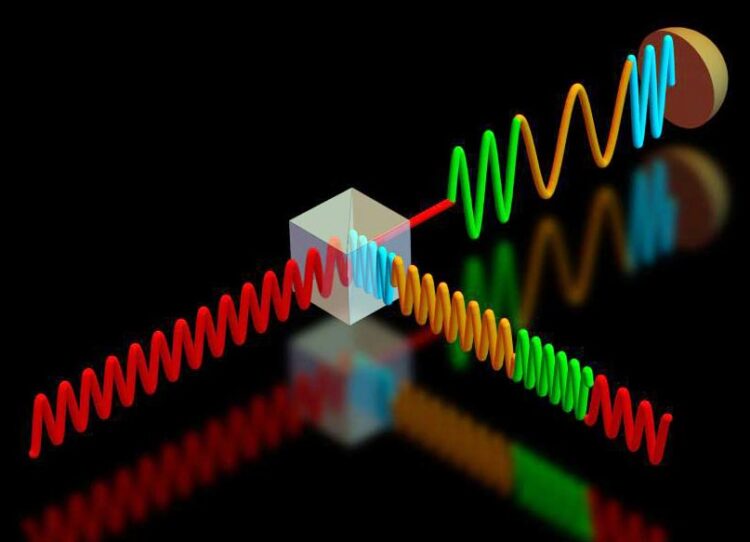Boosting fiber optics communications with advanced quantum-enhanced receiver

Illustration showing how single-photon detection is used for feedback. Once correct parameters for the reference beam are established, the input state is extinguished.
Credit: Ivan Burenkov
Technology could avert capacity crunch by enhancing bandwidth while reducing energy consumption.
Fiber optic technology is the holy grail of high-speed, long-distance telecommunications. Still, with the continuing exponential growth of internet traffic, researchers are warning of a capacity crunch.
In AVS Quantum Science, by AIP Publishing, researchers from the National Institute of Standards and Technology and the University of Maryland show how quantum-enhanced receivers could play a critical role in addressing this challenge.
The scientists developed a method to enhance receivers based on quantum physics properties to dramatically increase network performance while significantly reducing the error bit rate (EBR) and energy consumption.
Fiber optic technology relies on receivers to detect optical signals and convert them into electrical signals. The conventional detection process, largely as a result of random light fluctuations, produces “shot noise,” which decreases detection ability and increases EBR.
To accommodate this problem, signals must continually be amplified as pulsating light becomes weaker along the optic cable, but there is a limit to maintaining adequate amplification when signals become barely perceptible.
Quantum-enhanced receivers that process up to two bits of classical information and can overcome the shot noise have been demonstrated to improve detection accuracy in laboratory environments. In these and other quantum receivers, a separate reference beam with a single-photon detection feedback is used so the reference pulse eventually cancels out the input signal to eliminate the shot noise.
The researchers’ enhanced receiver, however, can decode as many as four bits per pulse, because it does a better job in distinguishing among different input states.
To accomplish more efficient detection, they developed a modulation method and implemented a feedback algorithm that takes advantage of the exact times of single photon detection. Still, no single measurement is perfect, but the new “holistically” designed communication system yields increasingly more accurate results on average.
“We studied the theory of communications and the experimental techniques of quantum receivers to come up with a practical telecommunication protocol that takes maximal advantage of the quantum measurement,” author Sergey Polyakov said. “With our protocol, because we want the input signal to contain as few photons as possible, we maximize the chance that the reference pulse updates to the right state after the very first photon detection, so at the end of the measurement, the EBR is minimized.”
###
The article “Practical quantum-enhanced receivers for classical communication” is authored by Ivan Burenkov, M.V. Jabir, and Sergey V. Polyakov. The article appears in AVS Quantum Science (DOI: 10.1116/5.0036959) and can be accessed at https:/
ABOUT THE JOURNAL
AVS Quantum Science, co-published by AIP Publishing and AVS, is a truly intradisciplinary journal that reaches from its foundations in quantum science into a breadth of areas from condensed matter and atomic, molecular and optical physics, to biology, chemistry, and materials science, as well as computer science and engineering. The journal places a strong emphasis on focused and comprehensive reviews and features perspectives and original research.
ABOUT AVS
AVS is an interdisciplinary, professional society with some 4,500 members worldwide. Founded in 1953, AVS hosts local and international meetings, publishes four journals, serves members through awards, training and career services programs and supports networking among academic, industrial, government, and consulting professionals. Its members come from across the fields of chemistry, physics, biology, mathematics, engineering and business and share a common interest in basic science, technology development and commercialization related to materials, interfaces, and processing. https:/
All latest news from the category: Information Technology
Here you can find a summary of innovations in the fields of information and data processing and up-to-date developments on IT equipment and hardware.
This area covers topics such as IT services, IT architectures, IT management and telecommunications.
Newest articles

Innovative 3D printed scaffolds offer new hope for bone healing
Researchers at the Institute for Bioengineering of Catalonia have developed novel 3D printed PLA-CaP scaffolds that promote blood vessel formation, ensuring better healing and regeneration of bone tissue. Bone is…

The surprising role of gut infection in Alzheimer’s disease
ASU- and Banner Alzheimer’s Institute-led study implicates link between a common virus and the disease, which travels from the gut to the brain and may be a target for antiviral…

Molecular gardening: New enzymes discovered for protein modification pruning
How deubiquitinases USP53 and USP54 cleave long polyubiquitin chains and how the former is linked to liver disease in children. Deubiquitinases (DUBs) are enzymes used by cells to trim protein…



